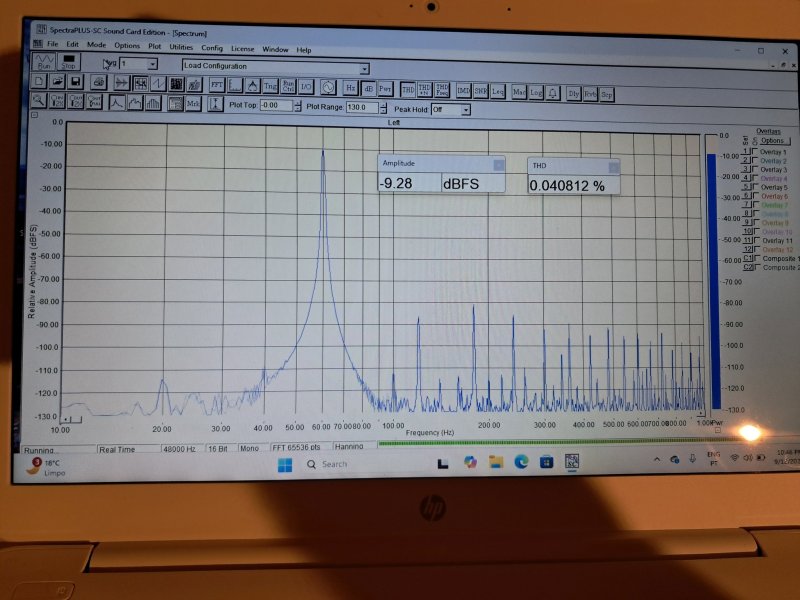Noise.
It permeates. It infiltrates. It is a deficiency that many here (and elsewhere) know nothing about.
There is a difference between a grey background and a calm, completely black void of any sound, within images, instruments or sweet nothings/whispers.
There are many different ways to achieve this. If you understand what "noise" actually is?
Tell us how you thwarted it.
Tom
I would very much appreciate help with a distortion problem.
It is not a hum or hiss; it is not the noise you don’t notice until it is gone. It is not essentially something to do with the background, but with the music itself. Piano almost always sounds good, but as music becomes more complex, or even louder, you hear a problem. When the problem is there, which it is more or less almost all the time now, my husband hears something like a sound of frying oil in a pan, sort of sizzling bubbles, plus tangled up sound and smearing when it is worse. I may hear something fuzzy but I have pulsatile tinnitus and it gets mixed up with it. The fuzziness is made up of random, lost bits of the music. I hear what is called graininess plus pitch problems, maybe time problems, tangling up, and clashing harmonics, harshness. I lose interest.
Note that we
have had what is for us perfect sound, with the same equipment. The last time was August 3 when we listened to some big choral pieces.
This problem is getting gradually worse. It used to be fixed by turning the system off at the wall overnight. Then it would creep in and after some days we would need to turn the system off; then one day it didn’t come good. Problem was the same playing an SACD direct to pre-amp, so not anything before that in playing digital music. Unplugging just the preamp from the P20 when sound was bad, then leaving it off for four hours fixed the sound too, but it deteriorated in the same way in a few days. So it was not the power conditioner. We changed the preamp (PSAudio BHK), which seemed to be causing the problem, but after two days of perfect sound with the new (Accuphase) preamp the problem came back. Now, turning it off at the wall doesn’t help, but it can improve by itself, though not entirely, with the present preamp.
The problem does not seem to be our gear; it does not seem to be the solar—that was turned off for some days and showed no difference; it is not something in the house since there is nothing that might be off for two entire days and then on for four days and then half on for three, etc. That sector has nothing else on except the modem and router. The meter box is 120m away on a shed with the solar, but I cannot imagine what would behave in this manner. It is not weather, time of day, day of week. It can deteriorate in the space of a half hour.
We thought it might be the grid, not us. We contacted the electric company and they thought it sounded like their side. They checked the various connections on their side (with a camera from the ground) and also monitored voltage and THD at our meter box over a week without finding any interference. So if there is an issue it is more subtle. We are at the edge of a small branch line of I think about 57 customers, of whom at least a third are absent a lot. This is a rural area in Australia and our nearest neighbours are at least 1k away. We have a transformer near the shed. At the shed THD is under 4 and the voltage is in recent times high, around 247 to 251 or so (I once saw 254). Years back, it varied more, from under 230 to over 250. The P20 registers slightly lower figures incoming than the electric company’s monitor or the Fronius inverter.
The sound problem comes unaffected through a PSAudio P20 and the complete Nordost QRT system and Tyr cables (which we were kindly lent). The Nordost gear gave great sound but didn’t help with this problem. I don’t think we can put in a dedicated line because there is nowhere now to put a new trench, but I have not investigated because it would be folly if we found the same problem having done that.
It has been fairly stable just lately, neither terrible nor perfect. When things are worst we cannot listen at all. When bad but not awful we can listen to piano and it may sound very nice, with inky background . When not good but not too bad, we can listen to a small group of instruments or a single voice with pleasure. It is particularly when there are multiple voices that I am unhappy even when the sound is okay but not close to perfect. Unfortunately, we like renaissance and baroque vocal music, which needs it to be perfect. It is for listening to that that we have this gear, which gives really nice sound.
Has anyone had this problem or know what it is? It is a power problem, but what do I call it when it isn't voltage or THD?
Thank you
P20, voltage in is usually higher—246-248, but not over 250, and THD in can be past 3 but not past 3.5.

Grid monitor (I gather that the B and C are not relevant)












